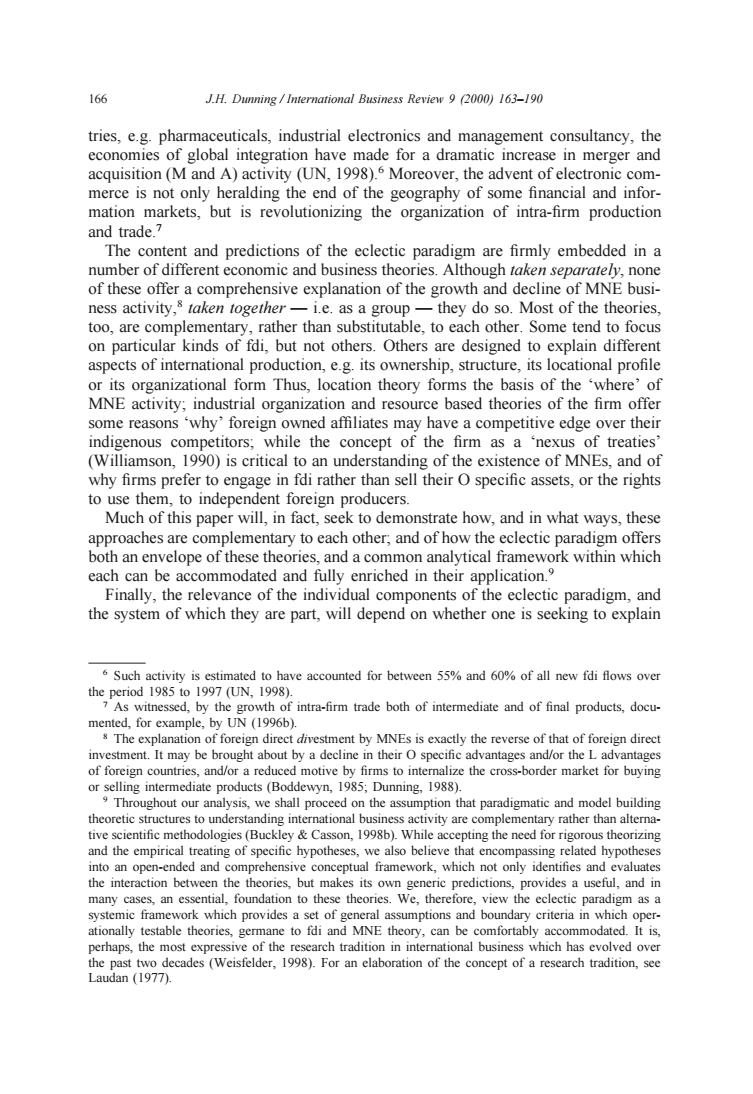正在加载图片...

166 J.H.Dunning/Intermational Business Review 9 (2000)163-190 tries,e.g.pharmaceuticals,industrial electronics and management consultancy,the economies of global integration have made for a dramatic increase in merger and acquisition(M and A)activity (UN,1998).Moreover,the advent of electronic com- merce is not only heralding the end of the geography of some financial and infor- mation markets,but is revolutionizing the organization of intra-firm production and trade.? The ntent and predictions of the eclectic paradigm are firmly embedded in a r of diffe rent and b none thes mprene an ctivity, 8, 1g0 st of he he too,are c th h othe fdi. ocu erational production,.g.its ownership.strco on partic ocational pronl or its organizational form Thus,location theory forms the basis of the 'where'of MNE activity;industrial organization and resource based theories of the firm offer some reasons 'why'foreign owned affiliates may have a competitive edge over their indigenous competitors;while the concept of the firm as a 'nexus of treaties (Williamson,1990)is critical to an understanding of the existence of MNEs,and of why firms prefer to engage in fdi rather than sell their O specific assets,or the rights to use them.to independent foreign producers. Much of this paper will,in fact,seek to demonstrate how,and in what ways,these Approaches are complementary to each other and of how the cclectic paradigm offers lone of these theories and a co non analytical framework within which each can be accommodated and fully enriched in their pplication. Finally. the rele ance of the individual components of the eclec tic paradigm,and the system of which they are par will deper nd on whether c ng t o explain Such activity is estimated to have accounted for between5%and%of all new fdi ows over of intra-firm trade both of intermediate and of final products,docu- mented,for example.by UN(9b) or selling interme ate products (Bo ewyn,1985:Dunning,1988) a ysis,we s procee n that par son.1998b).While accepting the need for rigo and the empirical ting of specific hypothese we also believ ing related hypothes the interaction between the thepries but makes its ow e predictions.p ovides a useful.and in many cases,an es foundation to thes theories.We.ther ew the eclectic par digm as a which provides a s and bo criteria in w d MNE ated. erhaps,the most ive of the research tradition in interational business which has evolved ove166 J.H. Dunning / International Business Review 9 (2000) 163–190 tries, e.g. pharmaceuticals, industrial electronics and management consultancy, the economies of global integration have made for a dramatic increase in merger and acquisition (M and A) activity (UN, 1998).6 Moreover, the advent of electronic commerce is not only heralding the end of the geography of some financial and information markets, but is revolutionizing the organization of intra-firm production and trade.7 The content and predictions of the eclectic paradigm are firmly embedded in a number of different economic and business theories. Although taken separately, none of these offer a comprehensive explanation of the growth and decline of MNE business activity,8 taken together — i.e. as a group — they do so. Most of the theories, too, are complementary, rather than substitutable, to each other. Some tend to focus on particular kinds of fdi, but not others. Others are designed to explain different aspects of international production, e.g. its ownership, structure, its locational profile or its organizational form Thus, location theory forms the basis of the ‘where’ of MNE activity; industrial organization and resource based theories of the firm offer some reasons ‘why’ foreign owned affiliates may have a competitive edge over their indigenous competitors; while the concept of the firm as a ‘nexus of treaties’ (Williamson, 1990) is critical to an understanding of the existence of MNEs, and of why firms prefer to engage in fdi rather than sell their O specific assets, or the rights to use them, to independent foreign producers. Much of this paper will, in fact, seek to demonstrate how, and in what ways, these approaches are complementary to each other; and of how the eclectic paradigm offers both an envelope of these theories, and a common analytical framework within which each can be accommodated and fully enriched in their application.9 Finally, the relevance of the individual components of the eclectic paradigm, and the system of which they are part, will depend on whether one is seeking to explain 6 Such activity is estimated to have accounted for between 55% and 60% of all new fdi flows over the period 1985 to 1997 (UN, 1998). 7 As witnessed, by the growth of intra-firm trade both of intermediate and of final products, documented, for example, by UN (1996b). 8 The explanation of foreign direct divestment by MNEs is exactly the reverse of that of foreign direct investment. It may be brought about by a decline in their O specific advantages and/or the L advantages of foreign countries, and/or a reduced motive by firms to internalize the cross-border market for buying or selling intermediate products (Boddewyn, 1985; Dunning, 1988). 9 Throughout our analysis, we shall proceed on the assumption that paradigmatic and model building theoretic structures to understanding international business activity are complementary rather than alternative scientific methodologies (Buckley & Casson, 1998b). While accepting the need for rigorous theorizing and the empirical treating of specific hypotheses, we also believe that encompassing related hypotheses into an open-ended and comprehensive conceptual framework, which not only identifies and evaluates the interaction between the theories, but makes its own generic predictions, provides a useful, and in many cases, an essential, foundation to these theories. We, therefore, view the eclectic paradigm as a systemic framework which provides a set of general assumptions and boundary criteria in which operationally testable theories, germane to fdi and MNE theory, can be comfortably accommodated. It is, perhaps, the most expressive of the research tradition in international business which has evolved over the past two decades (Weisfelder, 1998). For an elaboration of the concept of a research tradition, see Laudan (1977)